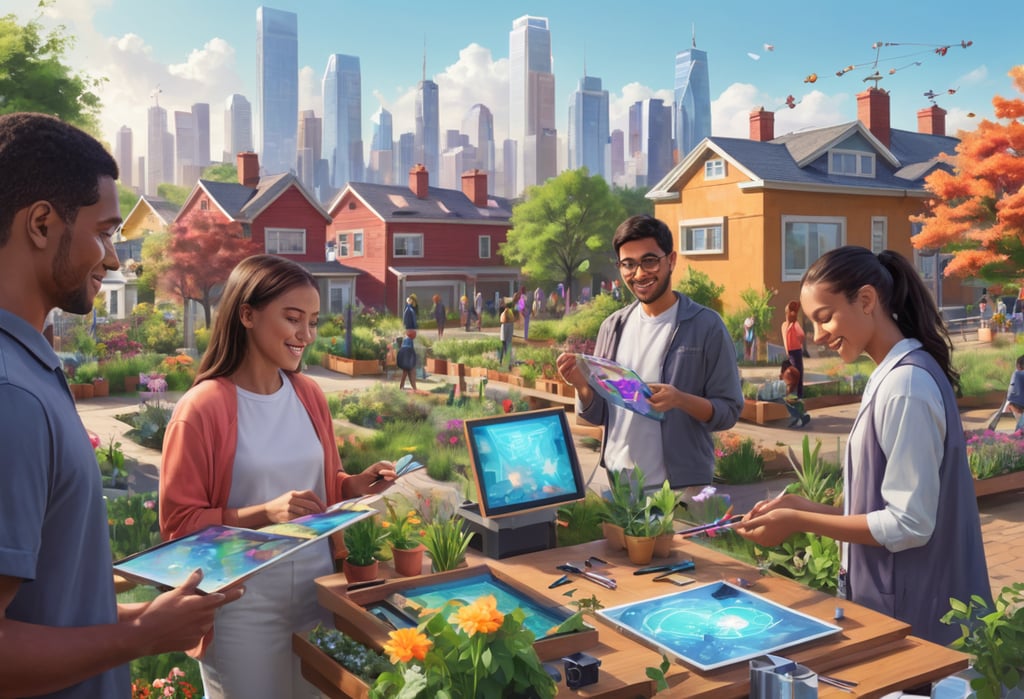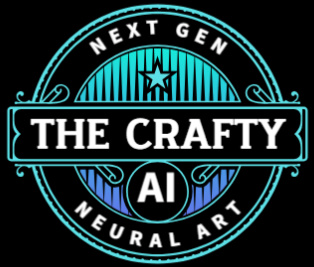Fun Things to Do with AI in Your Spare Time
Explore how AI automation will free time by 2035 as jobs like data entry and trucking fade. Discover creative pursuits, learning, community roles, leisure, and entrepreneurship with tools like Artbreeder and Duolingo, plus opportunities and challenges ahead.
AI FOR THE HOME


As Artificial Intelligence (AI) automates repetitive and routine tasks across industries, from manufacturing to customer service, many people will find themselves with more spare time than ever before. With jobs like data entry clerks, truck drivers, and call center agents at high risk of automation—potentially affecting 20-30% of current roles by 2030, according to McKinsey—individuals and societies face a transformative question: What will we do with this newfound time? This blog explores how people might repurpose their time in an AI-driven world, focusing on creative pursuits, lifelong learning, community engagement, leisure, and entrepreneurship, while addressing the challenges and opportunities of this shift.
The Automation Wave: Freeing Up Time
AI’s ability to handle repetitive tasks is reshaping the workforce. For instance, robotic process automation (RPA) can perform administrative tasks like invoicing in seconds, while autonomous vehicles, like those from Waymo, could replace millions of driving jobs. Studies estimate that automation could save workers 10-20 hours weekly by 2035, particularly in roles involving data processing, logistics, and customer interactions.
This shift doesn’t mean widespread unemployment but rather a reallocation of human effort. While some jobs vanish, others will emerge, such as AI system trainers or data ethicists. However, the immediate impact for many will be increased spare time, offering opportunities to redefine personal and societal priorities. How people choose to use this time will shape the future of work, culture, and well-being.
Pursuing Creative Passions
With more free time, many will turn to creative pursuits, unleashing a renaissance of self-expression. AI tools are already democratizing creativity, enabling amateurs to produce professional-quality content. Platforms like Canva use AI to simplify graphic design, while tools like Suno or AIVA help create music with minimal technical skill.
Art and Design: People may explore painting, digital art, or 3D modeling, using AI tools like DALL-E to generate initial concepts and refine their work. Online platforms like DeviantArt or Etsy could see a surge in user-generated art, turning hobbies into side hustles.
Writing and Storytelling: Aspiring authors can use AI writing assistants like Grammarly or Sudowrite to craft novels, blogs, or screenplays. The rise of self-publishing platforms like Kindle Direct Publishing will empower more people to share their stories.
Music and Performance: AI-driven music platforms allow users to compose songs or learn instruments via apps like Yousician, which adapts lessons to individual progress.
Case Study: Artbreeder
Artbreeder, an AI platform, lets users create unique digital art by blending images with machine learning. Hobbyists have used it to produce gallery-worthy pieces, with some selling their work as NFTs. By 2030, such platforms could enable millions to pursue art as a fulfilling pastime, potentially generating supplemental income.
Future Impact: Creative pursuits will flourish as AI lowers barriers to entry, allowing people to explore passions without needing formal training. This could lead to a cultural boom, with communities hosting more local art fairs, open mic nights, and digital galleries.
Lifelong Learning and Skill Development
Automation will push lifelong learning to the forefront, as workers adapt to an AI-driven job market. With spare time, people will invest in upskilling to stay competitive or pursue personal interests. AI-powered education platforms, like Coursera or Khan Academy, will offer personalized courses, adapting to individual learning paces and goals.
STEM Skills: Demand for data science, AI programming, and robotics skills will grow, with 36% job growth projected for data scientists by 2030 (U.S. Bureau of Labor Statistics). Free time can be used to learn Python or machine learning via platforms like Codecademy.
Soft Skills: Creativity, critical thinking, and emotional intelligence will remain in demand, as AI struggles to replicate these human traits. Courses on leadership or communication will thrive.
Hobbies as Skills: People may learn niche skills like urban farming, coding for games, or sustainable design, blending personal interests with marketable expertise.
Case Study: Duolingo
Duolingo’s AI-driven language learning app personalizes lessons, helping millions learn new languages in their spare time. By 2035, similar platforms could teach advanced skills like AI ethics or quantum computing, enabling career transitions or personal growth.
Future Impact: Lifelong learning will become a cultural norm, with individuals dedicating 5-10 hours weekly to education. This will foster a more adaptable workforce and enrich personal lives through intellectual exploration.
Community Engagement and Social Good
With more time, people will likely invest in their communities, strengthening social bonds and addressing local needs. Volunteerism and civic engagement could surge as individuals redirect energy from repetitive jobs to meaningful causes.
Volunteering: Organizations like Habitat for Humanity or local food banks may see increased participation, as people use spare time to build homes, mentor youth, or support environmental initiatives.
Grassroots Innovation: AI tools will empower community projects, such as apps for coordinating neighborhood cleanups or platforms for crowdfunding local businesses.
Advocacy and Activism: Free time could fuel activism, with individuals using AI-driven social media analytics to organize campaigns on issues like climate change or equality.
Case Study: Be My Eyes
Be My Eyes, an AI-supported app, connects volunteers with visually impaired individuals for real-time assistance. With more spare time, volunteer participation could grow, enhancing accessibility and community support.
Future Impact: Community engagement will strengthen social cohesion, with studies suggesting a 10-15% increase in volunteer hours by 2030. AI will amplify these efforts by matching volunteers with causes and optimizing outreach.
Leisure and Personal Well-Being
Leisure will take center stage as AI frees up time, allowing people to prioritize relaxation and personal growth. Streaming platforms, gaming, and immersive experiences will evolve, powered by AI.
Entertainment: Netflix and Spotify will use AI to curate hyper-personalized content, while virtual reality (VR) platforms like Meta’s Horizon Worlds will offer immersive social experiences, from virtual concerts to global meetups.
Travel and Exploration: With more time, people may travel locally or globally, using AI apps like Tripadvisor to plan personalized itineraries or explore virtual destinations via AR.
Health and Wellness: AI wearables will guide meditation, fitness, or sleep routines, helping people use leisure time to improve mental and physical health.
Case Study: Peloton
Peloton’s AI-driven fitness platform tailors workouts to user performance, encouraging consistent exercise. By 2030, similar tools could integrate with home robots, guiding yoga sessions or tracking wellness goals, making leisure time healthier.
Future Impact: Leisure will become more intentional, with people dedicating 15-20 hours weekly to activities that enhance well-being, from fitness to cultural exploration, fostering happier, healthier lives.
Entrepreneurship and Side Hustles
Spare time will fuel a surge in entrepreneurship, as AI lowers barriers to starting businesses. Platforms like Shopify or Etsy, combined with AI tools, will enable individuals to launch ventures with minimal upfront costs.
E-Commerce: AI-driven tools will help create online stores, optimize pricing, and target customers, enabling people to sell crafts, digital products, or services.
Content Creation: With AI simplifying video editing (e.g., Descript) or content generation, more people will become YouTubers, podcasters, or bloggers, monetizing their passions.
Gig Economy: Platforms like Upwork will use AI to match freelancers with projects, allowing people to offer skills like graphic design or consulting in their free time.
Case Study: Printful
Printful’s AI-driven print-on-demand platform lets users create custom merchandise without inventory. By 2035, similar platforms could enable millions to launch micro-businesses, turning hobbies into income streams.
Future Impact: Entrepreneurship could grow by 20%, with spare time enabling side hustles that supplement income or become full-time ventures, fostering economic resilience.
Challenges of Increased Spare Time
While spare time offers opportunities, it also poses challenges. Without structure, some may struggle with purposelessness or isolation, particularly if automation displaces jobs without adequate reskilling. Mental health support, like AI-driven apps such as Woebot, will be crucial to help individuals navigate this transition.
Economic inequality is another concern. Those with access to education and technology will thrive, while others may face barriers. Governments and companies must invest in reskilling programs, like Amazon’s Upskilling 2025, and policies like universal basic income to ensure equitable access to opportunities.
Predictions for the Next Decade
By 2035, people with more spare time will likely:
Dedicate 10-15 hours weekly to creative pursuits, boosting cultural output.
Invest 5-10 hours in lifelong learning, driving a 20% increase in online education enrollment.
Increase volunteerism by 15%, strengthening community bonds.
Spend 15-20 hours on leisure, enhancing well-being through AI-curated experiences.
Launch 20% more micro-businesses, fueled by AI tools and spare time.
Example: Singapore’s SkillsFuture
Singapore’s SkillsFuture program uses AI to recommend training, helping citizens upskill. By 2030, similar initiatives globally could ensure spare time is used productively, blending learning, creativity, and entrepreneurship.
Conclusion
As AI automates routine tasks, the gift of spare time will redefine how we live, work, and connect. People will channel this time into creative passions, lifelong learning, community engagement, leisure, and entrepreneurship, creating a more vibrant, connected, and resilient society. While challenges like inequality and purposelessness loom, proactive policies and AI-driven tools will help individuals navigate this shift. By 2035, spare time will not just be a byproduct of automation but a catalyst for personal growth and societal progress, empowering us to live more fulfilling lives.

